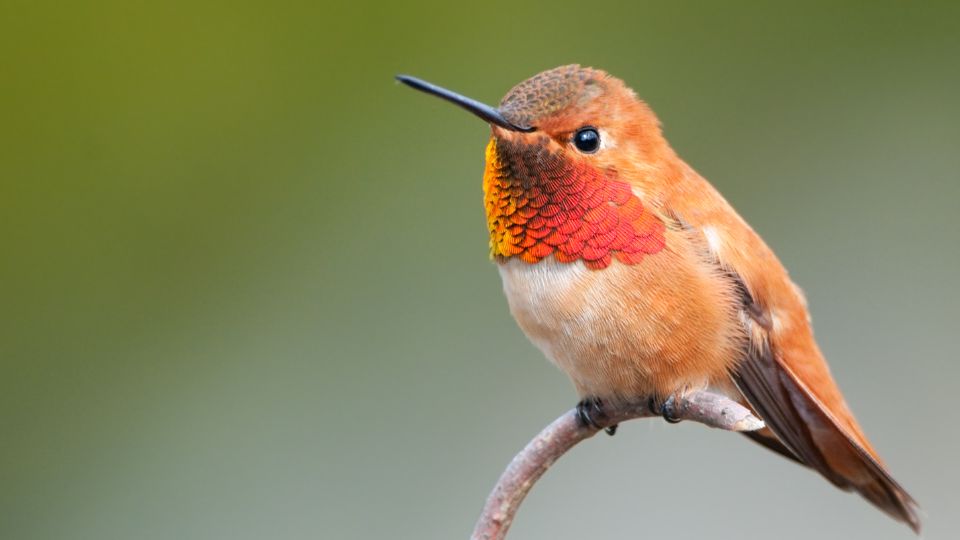Hummingbirds from the family Trochilidae are the tiniest birds. There are over 361 species of hummingbird, all of which can be found on the American continent. Most of these species are found in the tropics of South America and the Caribbean. Only eight hummingbird subspecies breed in North America.
Hummingbirds are the smallest migrating bird in the world; with their beautiful bright and iridescent plumage, these majestic birds are sure to catch your sight. They feed on native tubular flowers, preferring red or pink colors, insects, and nectar from backyard feeders. Hummingbirds eat at least three times their body weight each day in order to sustain their flight and activities.
These birds have been pushed to expand their migration areas due to habitat loss and more prevalent backyard feeders. Read on to learn more information about hummingbirds and which hummingbird species are in your state.
Table of Contents
How Many Species of Hummingbirds Are There?
There are over 361 known species of hummingbirds. Most are native and year-round residents of Central and South America. Scientists continue to discover new species of hummingbirds all the time. Hummingbirds, known scientifically as Trochiliformes, are the second most diverse order of birds after the passerines.
What Is The Most Common Species Of Hummingbird?
The Ruby-throated Hummingbird, scientific name Archilochus colubris, is the most common in the US. The male is known for his bright red throat (commonly referred to as a gorget) and bright green feathers. The female is a duller green with a pale-dirty white throat.

What Is The Rarest Hummingbird?
The rarest North American hummingbird is the Calothorax lucifer, the common name Lucifer Hummingbird. Males have a bright purple gorget with green feathers and a forked tail. They spend most of their time in the canyons of the desert southwest and are rarely seen at backyard hummingbird feeders. They also migrate to Texas and northern Mexico.
Is There A Hummingbird That Is Native To North America?
Around 15 species of hummingbirds are native to North America. All hummingbird species are native to the Americas, and most migrate between Canada and North and South America. Hummingbirds know it’s time to relocate because of small environmental changes, such as flower availability and weather patterns.
Species of Hummingbirds – Listed By State
Below are the US states listed alphabetically and the types of hummingbirds typically found in each state. The only US state without hummingbirds is Hawaii. Attracting hummers is against the law to preserve Hawaii’s pineapple crop.
The species of hummingbirds found in Canada are listed below in the US states. Note that some species of hummingbirds found in Central and South America will not be shown in this list.
Alabama
- Allen’s hummingbird—rare
- Anna’s hummingbird—spotted back in 2012
- Black-chinned hummingbird—regular sightings; common in the winter
- Broad-tailed Hummingbird
- Buff-Bellied Hummingbird—infrequently occurs; sighted in 2022
- Calliope Hummingbird
- Magnificent/Rivoli’s Hummingbird—extremely rare
- Ruby-throated Hummingbird—regular sightings; some stay through the winter
- Rufous Hummingbird—another winter visitor
Hummingbirds are more common in Alabama in the winter months.
Alaska:
- Anna’s Hummingbird
- Costa’s Hummingbird
- Ruby-Throated Hummingbird
- Rufous Hummingbird
Hummers arrive in Alaska later in the season—closer to mid-April—and begin to migrate south by mid-July.
Anna’s hummingbird, or Calypte anna, is most common on the Pacific Coastline and has been spotted as far north as Alaska. Adult males have a magenta throat and emerald feathers. In their courtship dives, they climb as high as 130 feet and then dive toward the female, making a burst of noise with their tail.
Arizona
- Allen’s Hummingbird
- Anna’s Hummingbird
- Berylline Hummingbird
- Black-chinned
- Blue-throated Mountain Gem
- Broad-billed, Broad-tailed
- Calliope Hummingbird
- Cinnamon Hummingbird
- Costa’s Hummingbird
- Lucifer Hummingbird
- Magnificent/Refulgent Hummingbird
- Plain-capped Hummingbird
- Starthroat Hummingbird
- Ruby-Throated Hummingbird
- Rufous Hummingbird
- Violet-crowned Hummingbird
- White-eared Hummingbird
Arizona is home to the most hummingbirds north of Mexico. In the 1990s, bird watchers reported a sighting of the Bee Hummingbird—the world’s smallest bird and normally native to Cuba.
Arkansas
- Anna’s hummingbird—spotted in 2022
- Black-chinned hummingbird—rare vagrant
- Broad-billed hummingbird—rare
- Broad-tailed hummingbird—spotted in 2021
- Calliope Hummingbird—rare
- Ruby-Throated Hummingbird—most frequent hummingbird spotted in summer
- Rufous Hummingbird—spotted almost year round
California:
- Allen’s Hummingbird
- Anna’s hummingbird—these hummers live here year-round
- Black-Chinned Hummingbird
- Broad-Tailed Hummingbird
- Broad-Billed Hummingbird
- Calliope Hummingbird—the smallest hummingbird in California
- Costa’s Hummingbird
- Rufous Hummingbird
Colorado:
- Anna’s Hummingbird
- Black-Chinned
- Broad-Tailed Hummingbird
- Blue-Throated
- Broad-Billed Hummingbird
- Calliope Hummingbird
- Costa’s Hummingbird
- Green Violet-Ear
- Magnificent/Refulgent Hummingbird
- Ruby-Throated Hummingbird
- Rufous Hummingbird
Here, hummingbirds arrive in mid-April and leave by mid-September.
The most common hummingbirds in the state are the Rufous Hummingbird, the Black-Chinned Hummingbird, and the Broad-Tailed Hummingbird.
The Magnificent or Refulgent Hummingbird (formerly known as Rivoli’s Hummingbird) has an iridescent purple head and a vibrant green gorget. It is the second largest hummingbird in the US.
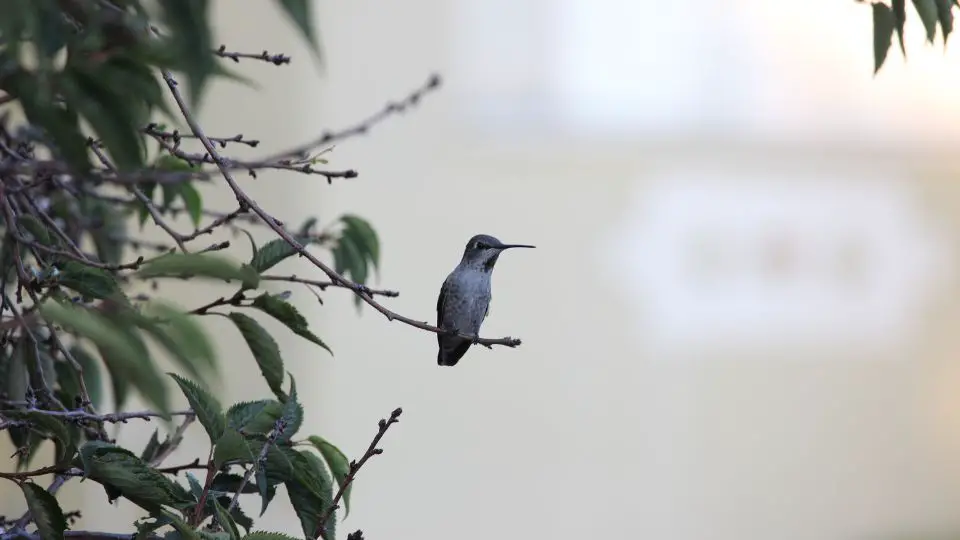
Connecticut
- Calliope Hummingbird
- Ruby-throated Hummingbird
- Rufous Hummingbird
Delaware
- Ruby-throated Hummingbird
- Rufous Hummingbird
Florida
- Anna’s Hummingbird
- Antillean Crested Hummingbird
- Bahama Woodstar Hummingbird
- Black-chinned Hummingbird
- Calliope Hummingbird
- Cuban Emerald Hummingbird
- Ruby-throated Hummingbird
- Rufous Hummingbird
Georgia
- Allen’s Hummingbird
- Anna’s Hummingbird
- Black-Chinned Hummingbird
- Broad-tailed Hummingbird
- Magnificent/Rivoli’s Hummingbird
- Ruby-Throated Hummingbird
- Rufous Hummingbird
Idaho
- Anna’s Hummingbird
- Black-chinned
- Broad-billed
- Broad-tailed Hummingbird
- Calliope Hummingbird
- Ruby-Throated Hummingbird
- Rufous Hummingbird
Hummingbirds arrive in Idaho around mid-May and leave by mid-September.
The male Broad-Tailed Hummingbird is known for its rounded tail feathers that whistle in flight. He has a rosy-red gorget and a metallic green back. Males arrive one or two weeks before females to prepare for the breeding season.
Illinois
- Allen’s Hummingbird
- Broad-billed Hummingbird
- Ruby-throated Hummingbird
- Rufous Hummingbird
Indiana
- Black-chinned hummingbird—a vagrant, spotted infrequently
- Ruby-throated Hummingbird—by far the most common hummer in the state
- Rufous Hummingbird
Male Black-chinned Hummingbirds are metallic green with a black chin and violet throat. The female has a whitish throat and white tips on her tail. Black-chinned hummingbirds are more common in the western US, preferring higher mountain elevations after breeding for the season.
Iowa
- Ruby-throated Hummingbird
- Rufous Hummingbird
Kansas
- Allen’s Hummingbird
- Anna’s Hummingbird
- Broad-billed Hummingbird
- Broad-tailed Hummingbird
- Calliope Hummingbird
- Costa’s Hummingbird
- Magnificent/Rivoli’s Hummingbird
- Ruby-throated Hummingbird—most common
- Rufous Hummingbird
Costa’s hummingbird is a vagrant in Kansas, with only a few sightings reported. Named in 1839 to commemorate the French ornithologist Louis Marie Pantaleon Costa, male Costa’s are known for their bright red-purple crown and gorget.
Kentucky
- Anna’s hummingbird—uncommon
- Black-chinned hummingbird—uncommon
- Mexican-violetear—very rare
- Ruby-throated Hummingbird—common
- Rufous Hummingbird—common
Louisiana
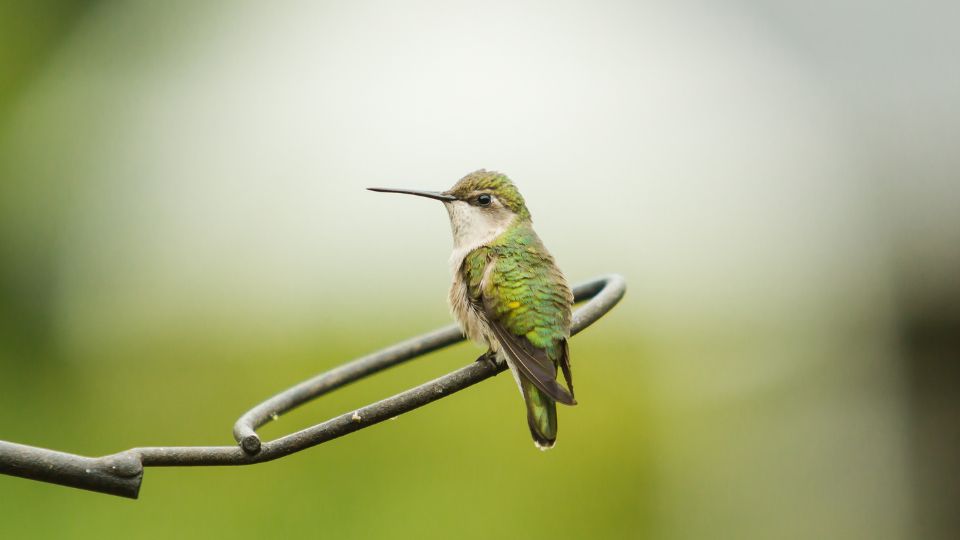
- Allen’s Hummingbird
- Anna’s Hummingbird
- Black-chinned Hummingbird
- Blue-throated Mountain Gem
- Broad-billed Hummingbird
- Buff-bellied Hummingbird
- Calliope Hummingbird
- Green/Mexican-violetear Hummingbird
- Magnificent/Rivoli’s Hummingbird
- Ruby-throated Hummingbird
- Rufous Hummingbird
Maine
- Ruby-throated Hummingbird
- Rufous Hummingbird
Maryland
- Ruby-throated Hummingbird
- Rufous Hummingbird
Massachusetts
- Allen’s hummingbird—seen in 2009
- Ruby-throated Hummingbird
- Rufous Hummingbird
Michigan
- Broad-billed Hummingbird
- Green-violetear/Mexican-violetear
- Ruby-throated Hummingbird
- Rufous Hummingbird
- White-eared Hummingbird
There was one reported sighting of the White-eared Hummingbird in Michigan in 2005. These hummingbirds are named for the white stripe above their eye, extending towards their neck. Males are a vibrant green with black and violet heads.
Minnesota
- Anna’s Hummingbird
- Calliope Hummingbird
- Magnificent/Rivoli’s Hummingbird
- Ruby-throated Hummingbird
- Rufous Hummingbird
Mississippi
- Allen’s Hummingbird
- Anna’s Hummingbird
- Black-chinned Hummingbird
- Broad-tailed Hummingbird
- Calliope Hummingbird
- Ruby-throated Hummingbird
- White-eared Hummingbird
Missouri
- Allen’s Hummingbird
- Anna’s Hummingbird
- Black-chinned Hummingbird
- Broad-tailed Hummingbird
- Calliope Hummingbird
- Green/Mexican-violetear Hummingbird
- Ruby-throated Hummingbird
- Rufous Hummingbird
Montana
- Anna’s Hummingbird
- Black-chinned Hummingbird
- Broad-tailed Hummingbird
- Calliope Hummingbird
- Rufous Hummingbird
Hummingbirds enter torpor to conserve energy and sustain their metabolism. The Broad-tailed hummingbird uses torpor especially to survive cold nights in their high-elevation habitats.
Nebraska
- Broad-tailed Hummingbird
- Calliope Hummingbird
- Ruby-throated Hummingbird
- Rufous Hummingbird
Nevada
- Allen’s Hummingbird
- Anna’s Hummingbird
- Black-chinned Hummingbird
- Broad-billed Hummingbird
- Broad-tailed Hummingbird
- Calliope Hummingbird
- Costa’s Hummingbird
- Rufous Hummingbird
New Hampshire
- Ruby-throated Hummingbird
- Rufous Hummingbird
New Jersey
- Ruby-throated Hummingbird
- Rufous Hummingbird
New Mexico
- Allen’s Hummingbird
- Anna’s Hummingbird
- Berylline Hummingbird
- Black-chinned Hummingbird
- Blue-throated Mountain Gem
- Broad-billed Hummingbird
- Broad-tailed Hummingbird
- Calliope Hummingbird
- Cinnamon Hummingbird
- Costa’s Hummingbird
- Lucifer Hummingbird
- Magnificent Hummingbird
- Plain-Capped Hummingbird
- Starthroat Hummingbird
- Ruby-throated Hummingbird—rare here
- Rufous Hummingbird
- Violet-crowned Hummingbird
Allen’s Hummingbird, or Selasphorus sasin, is found in most of the western states. The male has both rufous and green feathers and a rufous tail and eye patch. Allen’s hummingbirds migrate to the southwestern US for breeding grounds but live in both the US and Mexico year-round.
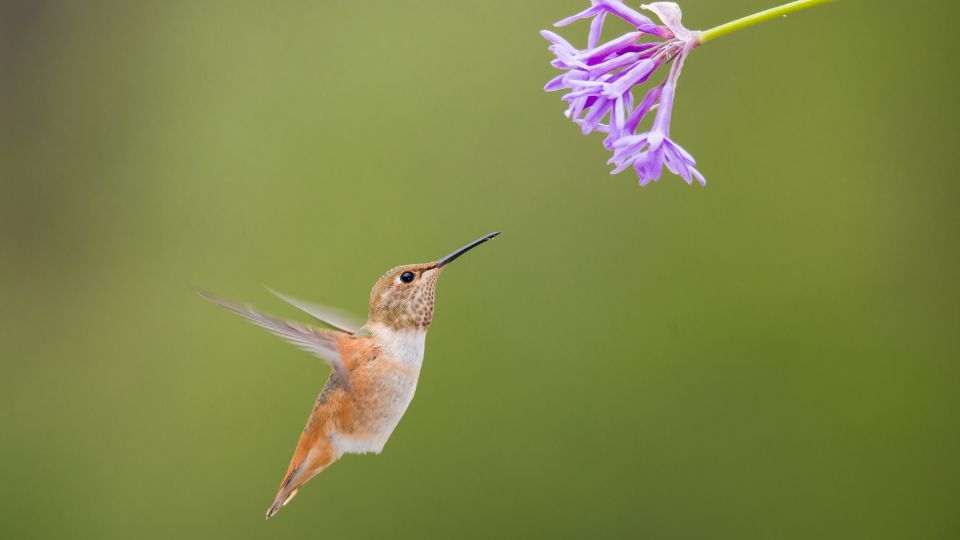
New York
- Calliope Hummingbird
- Ruby-throated Hummingbird
- Rufous Hummingbird
North Carolina
- Calliope Hummingbird
- Green-breasted Mango Hummingbird
- Mexican-violetear Hummingbird
- Ruby-throated Hummingbird
- Rufous Hummingbird
North Dakota
- Ruby-throated Hummingbird
- Rufous Hummingbird
Hummingbirds are rare in North Dakota.
Ohio
- Anna’s Hummingbird
- Calliope Hummingbird
- Mexican-violetear
- Ruby-Throated Hummingbird
- Rufous Hummingbird
Oklahoma
- Anna’s Hummingbird
- Black-chinned Hummingbird
- Broad-tailed Hummingbird
- Calliope Hummingbird
- Ruby-throated Hummingbird
- Rufous Hummingbird
Oregon
- Anna’s Hummingbird
- Allen’s Hummingbird
- Black-Chinned Hummingbird
- Calliope Hummingbird
- Rufous Hummingbird
The Rufous Hummingbird, with the scientific name Selasphorus Rufus, is known for its coppery-orange plumage. These hummingbirds stay mainly on the Pacific Coastline from Mexico to British Columbia and into Alaska. Rufous refers not only to this hummingbird but to the orange color in general.
Pennsylvania
- Anna’s Hummingbird
- Allen’s Hummingbird
- Calliope Hummingbird
- Ruby-throated Hummingbird
- Rufous Hummingbird
Rhode Island
- Ruby-throated Hummingbird
- Rufous Hummingbird
South Carolina
- Mexican-violetear
- Ruby-throated Hummingbird
- Rufous Hummingbird
South Dakota
- Broad-tailed Hummingbird
- Calliope Hummingbird
- Ruby-throated Hummingbird
- Rufous Hummingbird
Hummingbirds are rare in South Dakota.
Tennessee
- Allen’s Hummingbird
- Calliope Hummingbird
- Black-chinned Hummingbird
- Ruby-throated Hummingbird
- Rufous Hummingbird
Texas
- Allen’s Hummingbird
- Anna’s Hummingbird
- Black-chinned
- Blue-Throated Mountain Gem
- Buff-bellied Hummingbirds—Facing Habitat Loss
- Calliope Hummingbird
- Costa’s Hummingbird
- Lucifer Hummingbird
- Magnificent Hummingbird
- Mexican-violetear
- Ruby-throated Hummingbird
- Rufous Hummingbird
- Violet-crowned Hummingbird
- White-eared Hummingbird
The Blue-throated was renamed the Blue-throated Mountain Gem in 2019. Though more common in Mexico, there have been sightings in Arizona and Texas.
Utah
- Anna’s Hummingbird
- Black-chinned
- Broad-billed Hummingbird
- Broad-tailed Hummingbird
- Calliope Hummingbird
- Costa’s Hummingbird
- Magnificent hummingbird—has one of the highest heart rates of all vertebrates. It can reach 1,200 beats per minute!
- Rufous Hummingbird
Vermont
- Ruby-throated Hummingbird
- Rufous Hummingbird
Virginia
- Allen’s Hummingbird
- Calliope Hummingbird
- Black-chinned Hummingbird
- Ruby-throated Hummingbird
- Rufous Hummingbird
Washington
- Anna’s Hummingbird
- Black-chinned Hummingbird
- Calliope Hummingbird
- Rufous Hummingbird
West Virginia
- Black-chinned Hummingbird
- Mexican-violetear Hummingbird
- Ruby-throated Hummingbird
- Rufous Hummingbird
Wisconsin
- Anna’s Hummingbird
- Broad-billed hummingbird—rare vagrant
- Mexican-violetear—uncommon
- Ruby-throated Hummingbird
- Rufous Hummingbird
Wyoming
- Anna’s Hummingbird
- Black-chinned
- Broad-tailed Hummingbird
- Calliope Hummingbird
- Magnificent Hummingbird
- Rufous Hummingbird
Canadian Provinces
Though less prevalent in Canada, hummingbirds are most common in western Canada. Hummingbirds migrate especially through British Columbia on their way up and down the Pacific Coast.
Alberta
- Anna’s Hummingbird
- Black-chinned Hummingbird
- Calliope Hummingbird
- Costa’s Hummingbird
- Mexican Violetear Hummingbird
- Ruby-throated Hummingbird
- Rufous Hummingbird
British Columbia
- Allen’s Hummingbird
- Anna’s Hummingbird
- Black-chinned Hummingbird
- Calliope Hummingbird
- Costa’s Hummingbird
- Ruby-throated Hummingbird
- Rufous Hummingbird
Manitoba
- Broad-tailed Hummingbird
- Ruby-throated Hummingbird
- Rufous Hummingbird
New Brunswick
- Broad-billed Hummingbird
- Broad-chinned Hummingbird
- Ruby-throated Hummingbird
- Rufous Hummingbird
Newfoundland
- Ruby-throated Hummingbird
- Rufous Hummingbird
Northwest Territories
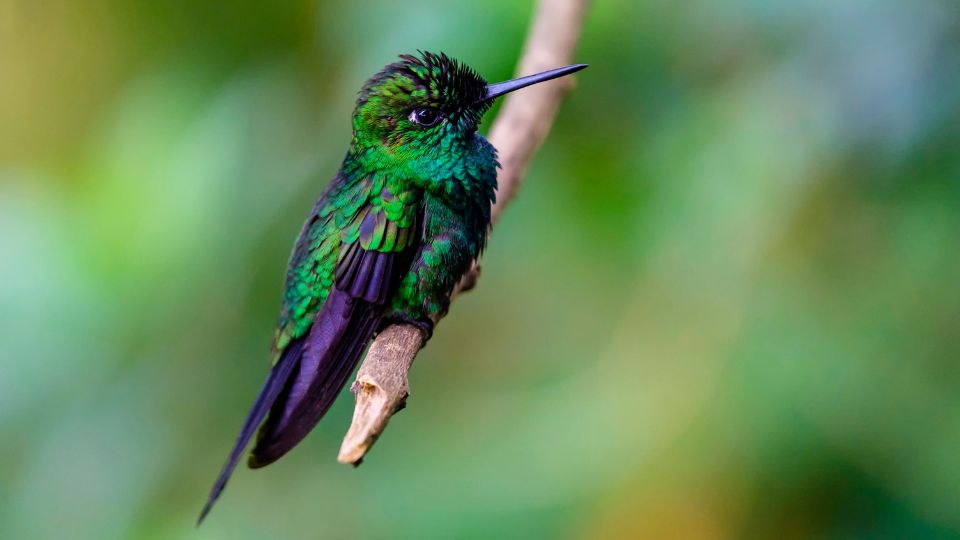
- Ruby-throated Hummingbird
- Rufous Hummingbird
Nova Scotia
- Ruby-throated Hummingbird
- Rufous Hummingbird
Ontario
- Black-chinned Hummingbird
- Broad-billed Hummingbird
- Mexican Violet-ear
- Ruby-throated Hummingbird
- Rufous Hummingbird
Prince Edward Island
- Ruby-throated Hummingbird
Quebec
- Ruby-throated Hummingbird
Saskatchewan
- Black-chinned Hummingbird
- Calliope Hummingbird
- Ruby-throated Hummingbird
- Rufous Hummingbird
Yukon
- Rufous Hummingbird
Central America and South America
Central and South America boast the most species of hummingbirds. Columbia is home to 165 species of hummingbirds, while Ecuador has 132. Some of the hummingbird species include:
- Amazilia Hummingbird
- Bee Hummingbird—native to Cuba
- Berylline Hummingbird
- Cinnamon Hummingbird
- Esmeraldas Woodstar Hummingbird—one of the rarest and smallest birds, barely bigger than a bumblebee
- Green-breasted Mango—lives in the Caribbean.
- Long-tailed Sylph Hummingbird
- Violet Sabrewing
- White-necked Jacobin
- Xantus’s hummingbird—is found only on the Baja Peninsula and has a bright green body with a rufous (orange) tail. The male has a dark face with a white stripe above his eye.

